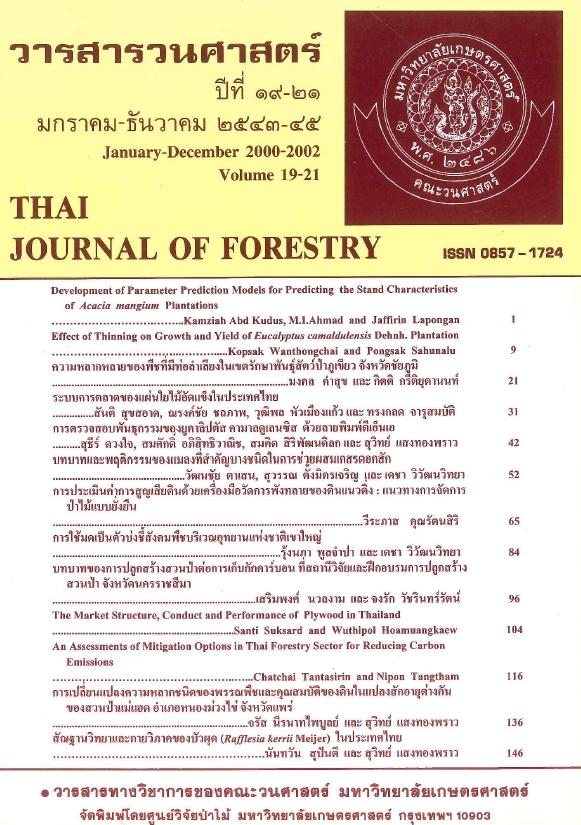การตรวจสอบพันธุกรรมของยูคาลิปตัส คามาลดูเลนซิส ด้วยลายพิมพ์ดีเอ็นเอ
Main Article Content
บทคัดย่อ
การตรวจสอบพันธุกรรมของยูคาลิปตัส คามาลดูเลนซิสด้วยลายพิมพ์ดีเอ็นเอโดยใช้เทคนิคอาร์เอพีดี ใช้ตัวอย่างในการศึกษาทั้งหมด 38 ตัวอย่าง ประกอบด้วยสายต้น S10 สายต้น T5 ลูกที่เกิดจากการผสมตัวเองของ แต่ละสายต้นจำนวน 14 ตัวอย่างและลูกที่เกิดจากการผสมข้ามระหว่างสองสายต้นจำนวน 22 ตัวอย่าง โดยมีวัตถุประสงค์เพื่อพัฒนาเทคนิคอาร์เอพีดีในการตรวจสอบพันธุกรรมของยูคาลิปตัส คามาลดูเลนซิส และตรวจสอบพันธุกรรมของยูคาลิปตัส คามาลดูเลนซิสบางสายต้นที่มีลักษณะดีบางประการพร้อมทั้งหาความสัมพันธ์ทางพันธุกรรมโดยใช้โปรแกรมคอมพิวเตอร์สำเร็จรูป NTSYS-PC เวอร์ชัน 18 ผลการศึกษาพบว่า วิธีการสกัดดีเอ็นเอที่ดัดแปลงมาจากวิธีของ Agrawal และคณะ (1992) สามารถใช้ในการสกัดดีเอ็นเอของยูคาลิปตัส คามาลดูเลนซิสอย่างได้ผลดี การตรวจลายพิมพ์ดีเอ็นเอของยูคาลิปตัสคามาลดูเลนซิสโดยใช้เทคนิคอาร์เอพีดีด้วยไพรเมอร์ขนาด 10 นิวคลีโอไทด์ พบว่าไพรเมอร์จำนวน 10 ชนิดจากทั้งหมด 82 ชนิดสามารถเพิ่มปริมาณดีเอ็นเอได้และก่อให้เกิดแถบดีเอ็นเอทั้งหมด 51 แถบ ในจำนวนนั้นมีไพรเมอร์ 6 ชนิดที่สามารถก่อให้เกิดความแตกต่างของลายพิมพ์ดีเอ็นเอและมีไพรเมอร์ 5 ชนิดที่สามารถประยุกต์ใช้ในการทำ genetic linkage map และเครื่องหมายช่วยในการคัดเลือก (marker assisted selection, MAS) ของยูคาลิปตัส คามาลดูเลนซิส จากการตรวจสอบลักษณะการถ่ายทอดสามารถจำแนกลักษณะโฮโมไซกัสและเฮเทอโรไซกัสของแถบดีเอ็นเอและมีการถ่ายทอดลักษณะแถบดีเอ็นเอเป็นไปตามกฎของเมนเดล ยูคาลิปตัส คามาลดูเลนซิสทั้ง 38 ตัวอย่างมีความคล้ายคลึงทางพันธุกรรมมากกว่า 90 เปอร์เซ็นต์ และสามารถแบ่งกลุ่มออกเป็นสองกลุ่มที่มีความแตกต่างของการปรากฏของแถบดีเอ็นเอบางแถบ
Downloads
Article Details

อนุญาตภายใต้เงื่อนไข Creative Commons Attribution-NonCommercial-NoDerivatives 4.0 International License.
ข้าพเจ้าและผู้เขียนร่วม (ถ้ามี) ขอรับรองว่า ต้นฉบับที่เสนอมานี้ยังไม่เคยได้รับการตีพิมพ์และไม่ได้อยู่ในระหว่างกระบวนการพิจารณาตีพิมพ์ลงในวารสารหรือสิ่งตีพิมพ์อื่นใด ข้าพเจ้าและผู้เขียนร่วม (ถ้ามี) ยอมรับหลักเกณฑ์และเงื่อนไขการพิจารณาต้นฉบับ ทั้งยินยอมให้กองบรรณาธิการมีสิทธิ์พิจารณาและตรวจแก้ต้นฉบับได้ตามที่เห็นสมควร พร้อมนี้ขอมอบลิขสิทธิ์ผลงานที่ได้รับการตีพิมพ์ให้แก่วารสารวนศาสตร์ คณะวนศาสตร์ มหาวิทยาลัยเกษตรศาสตร์ กรณีมีการฟ้องร้องเรื่องการละเมิดลิขสิทธิ์เกี่ยวกับภาพ กราฟ ข้อความส่วนใดส่วนหนึ่ง หรือ ข้อคิดเห็นที่ปรากฏในผลงาน ให้เป็นความรับผิดชอบของข้าพเจ้าและผู้เขียนร่วม (ถ้ามี) แต่เพียงฝ่ายเดียว และหากข้าพเจ้าและผู้เขียนร่วม (ถ้ามี) ประสงค์ถอนบทความในระหว่างกระบวนการพิจารณาของทางวารสาร ข้าพเจ้าและผู้เขียนร่วม (ถ้ามี) ยินดีรับผิดชอบค่าใช้จ่ายทั้งหมดที่เกิดขึ้นในกระบวนการพิจารณาบทความนั้น”


